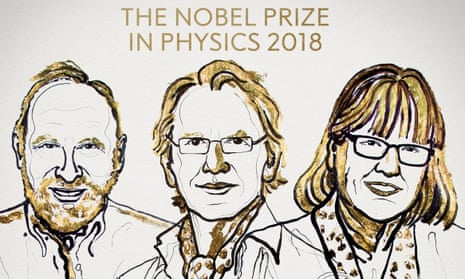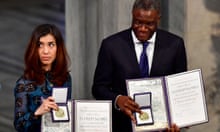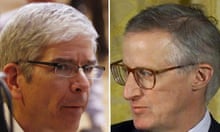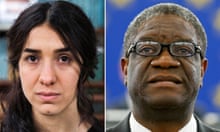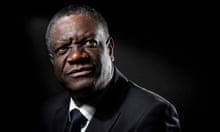Three scientists have been awarded the 2018 Nobel prize in physics for creating groundbreaking tools from beams of light.
The American physicist Arthur Ashkin, Gérard Mourou from France, and Donna Strickland in Canada will share the 9m Swedish kronor (£770,000) prize announced by the Royal Swedish Academy of Sciences in Stockholm on Tuesday. Strickland is the first female physics laureate for 55 years.
Ashkin, an affiliate of Bell Laboratories in New Jersey, wins half of the prize for his development of “optical tweezers”, a tractor beam-like technology that allows scientists to grab atoms, viruses and bacteria in finger-like laser-beams. The effect was demonstrated by the award committee by levitating a ping pong ball with a hairdryer.
Mourou at the École Polytechnique near Paris, and Strickland at the University of Waterloo in Ontario, each receive a quarter of the prize for work that paved the way for the shortest, most intense laser beams ever created. Their technique, named chirped pulse amplification, is now used in laser machining and enables doctors to perform millions of corrective laser eye surgeries every year.
Giving her reaction to the call from Stockholm early on Tuesday morning, Strickland said: “First of all, you have to think it is crazy.” She is the first woman to win the physics Nobel since Maria Goeppert Mayer was honoured in 1963 for her work on the nuclear shell structure. Strickland becomes only the third woman in history to win the physics prize, and the only living female physics laureate.
In a telephone interview with the Royal Swedish Academy, Strickland said she was unaware only two women had won the prize before her. “We need to celebrate women physicists because we’re out there, and hopefully in time it’ll start to move forward at a faster rate. I’m honoured to be one of those women,” she said.
The head of the academy, Goran Hansson, acknowledged that it was doing more to ensure women were not overlooked for Nobel prizes. “It’s a small percentage for sure,” Hansson said on the proportion of women who have won the physics prize. “That’s why we are taking measures to encourage more nominations because we don’t want to miss anyone.”
Ashkin, who at 96 is the oldest winner of any Nobel prize, told the committee that he may not be able to give any interviews because he was “very busy” on his latest scientific paper. He had previously complained of being overlooked for the Nobel prize in 1997 when another Bell Labs researcher, the US physicist Steven Chu, shared the award for cooling and trapping atoms with lasers.
Through his research in the 1970s and 80s, Ashkin showed how the radiation pressure of light could be harnessed to move physical objects without burning them, realising “an old dream of science fiction,” according to the Swedish Academy. In 1987, Ashkin published a landmark paper showing how optical tweezers could capture living bacteria without harming them.
Around the same time, Mourou and Strickland demonstrated how to create ultrashort, intense bursts of laser light by stretching, amplifying and finally recompressing light waves. Mourou said he had a key insight into solving the problem while riding on a ski lift at Bristol Mountain resort in Rochester, New York. The pair’s seminal paper in 1985 was Strickland’s first as an academic.
Ultra-sharp laser beams make it possible to cut or drill holes in various materials extremely precisely – even in living matter. Millions of eye operations are performed every year with the sharpest of laser beams.#NobelPrize pic.twitter.com/MiYb4i8AHw
— The Nobel Prize (@NobelPrize) October 2, 2018
Amanda Wright, associate professor at the faculty of engineering, University of Nottingham, said she was “delighted” with the prize announcement. She said a recently-funded collaboration between Nottingham, Heriot Watt and the University of Glasgow will use optical tweezers to explore how cells talk to their surroundings and vice versa, “and how these interactions affect disease progression.”
Jim Al-Khalili, professor of theoretical physics at the University of Surrey, added: “The most thrilling thing for me is to see Donna Strickland share this year’s prize. It is quite shocking to know that she is only the third woman to win a physics Nobel ever,” said “It is also quite delicious that this comes just a few days after certain controversial and misogynistic comments made at a conference at Cern about women in physics.
Congrats! Gérard Mourou immediately after receiving the news that he had been awarded the 2018 #NobelPrize in Physics.
— The Nobel Prize (@NobelPrize) October 2, 2018
Credit: Mme Catherine Sarrazin pic.twitter.com/c87TamN75Q
“Ashkin, Mourou and Strickland are all hugely deserving of this prize: their work on lasers will, I have no doubt, lead to other discoveries and further Nobel prizes in the future,” he added.
On Monday, James Allison at Texas MD Anderson Cancer Center in Houston and Tasuku Honjo at the University of Kyoto won the 2018 medicine Nobel for their work on harnessing the immune system to combat cancer. The award for chemistry will be announced on Wednesday, followed by peace on Friday and economics on Monday. The literature award is not being given this year after a scandal that resulted in a rape conviction on Monday.
